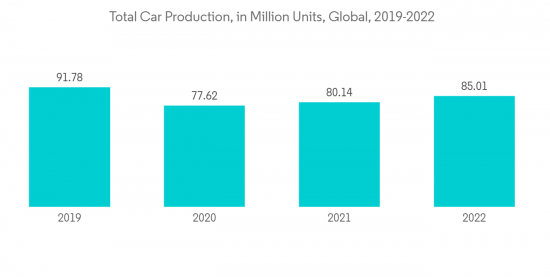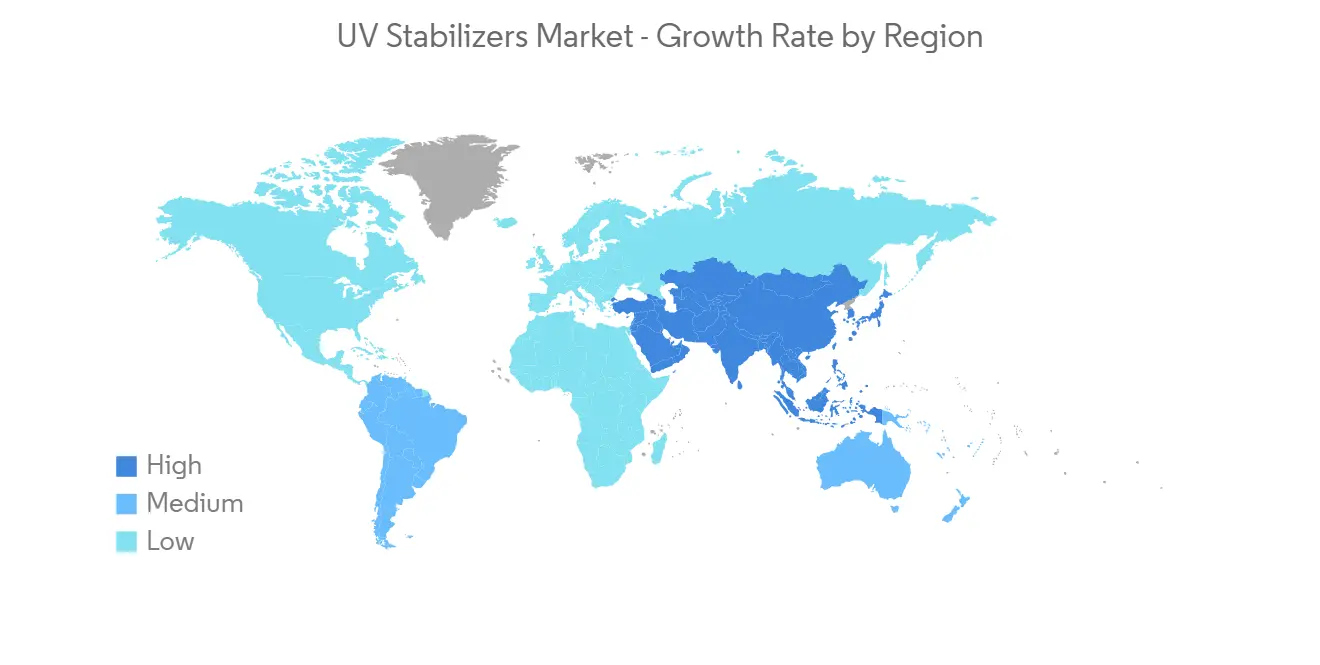 |
市场调查报告书
商品编码
1331287
紫外线稳定剂的市场规模和份额分析 - 增长趋势和预测(2023-2028)UV Stabilizers Market Size & Share Analysis - Growth Trends & Forecasts (2023 - 2028) |
||||||
※ 本网页内容可能与最新版本有所差异。详细情况请与我们联繫。
紫外线稳定剂的全球市场规模预计到 2023 年为 13 亿美元,预计到 2028 年将达到 17.3 亿美元,预计在预测期内(2023-2028 年)复合年增长率为 5.91%。
推动该市场增长的主要因素包括聚合物行业中紫外线稳定剂消耗量的增加以及木器涂料中紫外线稳定剂需求的增加。
主要亮点
- 另一方面,新冠肺炎 (COVID-19) 的负面经济影响预计将阻碍市场增长。
- 预计亚太地区将在预测期内主导市场。
- 按产品类型划分,受阻胺光稳定剂 (HALS) 在预测期内占据最高的市场份额。
紫外线稳定剂市场趋势
汽车行业主导市场
- 汽车中紫外线稳定剂的主要应用领域包括内饰件(门板、装饰件、窗框、中控台等)和外饰件(保险槓、支架、侧饰条等)。
- 根据国际汽车製造商协会 (OICA) 的数据,2022 年全球汽车和车辆生产总量将为 8,501 万辆,2021 年将达到 8,014 万辆。
- 此外,根据S&P Global Mobility的数据,2022年全球乘用车产量将达到6816万辆,同比增长7.9%。
- 2021 年亚洲/大洋洲地区汽车产量将达到 4,673 万辆,美洲地区汽车产量将达到 1,615 万辆,分别比 2020 年增长 6% 和 3%。 然而,2021年欧洲产量为1634万台,较2020年产量减少4%。
- 在阿根廷、印度尼西亚、摩洛哥、乌克兰和泰国等新兴国家,汽车产量同比增长超过10%。
- 《华尔街日报》援引汽车研究团体 LMC Automotive 和 EV-Volumes 的初步研究报告称,到 2022 年,全球电动汽车销量将达到 780 万辆,比 2021 年增长 68%。 根据这些报告,到2022年,电动汽车将占全球汽车销量的10%。 一些研究人员预测,到 2030 年,电动汽车行业的市场份额将增加一倍甚至四倍。
- 因此,此类汽车行业因素可能会对未来几年所研究的市场需求产生重大影响。

亚太地区主导市场
- 由于建筑、包装和汽车行业的显着增长,预计亚太地区将主导市场。
- 疫情过后,中国汽车工业有所增长。 汽车产量从2021年的2608万辆增加到2022年的2702万辆,2022年增长3%。
- 此外,根据中国工业和资讯化部的数据,到 2025 年国内汽车产量将达到 3500 万辆,进一步巩固其作为全球领先汽车製造商之一的地位。
- 在印度,随着大多数人口从农村迁移到城市地区,特别是随着食品服务的增加,食品包装行业正在经历快速增长。 印度每年消耗 200 亿个食品和饮料包装。
- 2030 年将消耗约 500 亿个包装,其中饮料包装增长率为 8%。 预计该国食品包装的增长将在预测期内增加对紫外线稳定剂的需求。
- 由于木工和细木工应用的增加,黏合剂和密封剂已成为韩国的主要市场之一。 此外,家具需求的增长也加速了粘合剂的需求,支持了整个行业的增长。 随着製造商不断扩大业务能力,粘合剂在电子行业的发展也呈上升趋势。
- 例如,2022年8月,汉高韩国宣布位于仁川松岛高科技产业集群的松岛工厂竣工。 该工厂预计将成为粘合剂技术部门高影响力电子解决方案的亚太生产基地。
- 这些因素可能会在预测期内推动亚太地区紫外线稳定剂市场的发展。

紫外线稳定剂行业概述
全球紫外线稳定剂市场正在一体化。 市场主要参与者(排名不分先后)包括 BASF SE、SONGWON、Solvay、CLARIANT 和 SABO S.p.A.。
其他好处:
- Excel 格式的市场预测 (ME) 表
- 3 个月的分析师支持
目录
第 1 章简介
- 调查的先决条件
- 调查范围
第 2 章研究方法
第 3 章执行摘要
第 4 章市场动态
- 促进因素
- 聚合物行业的消费不断增加
- 木器涂料的需求不断增加
- 抑制因素
- 原材料价格变化
- 价值链分析
- 波特五力分析
- 供应商的议价能力
- 消费者议价能力
- 新进入者的威胁
- 替代品的威胁
- 竞争程度
第 5 章市场细分(基于价值的市场规模)
- 类型
- 紫外线吸收剂
- 受阻胺光稳定剂 (HALS)
- 猝灭剂
- 抗氧化剂
- 最终用户行业
- 包装
- 汽车
- 农业
- 建筑/施工
- 粘合剂和密封剂
- 其他最终用户行业
- 地区
- 亚太地区
- 中国
- 印度
- 日本
- 韩国
- 其他亚太地区
- 北美
- 美国
- 加拿大
- 墨西哥
- 欧洲
- 德国
- 英国
- 法国
- 意大利
- 欧洲其他地区
- 南美洲
- 巴西
- 阿根廷
- 南美洲其他地区
- 中东/非洲
- 沙特阿拉伯
- 南非
- 其他中东和非洲地区
- 亚太地区
第 6 章竞争态势
- 併购、合资企业、联盟、协议
- 市场排名分析
- 各大公司的战略
- 公司简介
- ADEKA CORPORATION
- ALTANA AG
- BASF SE
- Chitec Technology Co., Ltd.
- CLARIANT
- Eastman Chemical Company
- Everlight Chemical Industrial Co.
- Lycus Ltd., LLC.
- Mayzo, Inc.
- Rianlon Corporation
- SABO S.p.A.
- SI Group Inc.(SK Capital Partners)
- Solvay
- SONGWON
- UniteChem Group
第 7 章市场机会和未来趋势
- 紫外稳定剂纳米复合材料
- 扩大在製药行业的应用
The Global UV Stabilizer Market size is estimated at USD 1.30 billion in 2023, and is expected to reach USD 1.73 billion by 2028, growing at a CAGR of 5.91% during the forecast period (2023-2028).
The major factors driving the growth of the market studied include the rising consumption of UV stabilizers in the polymer industry and increasing demand for UV stabilizers from wood coatings.
Key Highlights
- On the flipside, the negative economic effects of COVID-19 are expected to hinder the growth of the market studied.
- Asia-Pacific is expected to dominate the market studied during the forecast period.
- Among the product types, Hindered Amine Light Stabilizers (HALS) accounted for the highest market share during the forecast period.
UV Stabilizers Market Trends
Automotive Sector to Dominate the Market
- Some of the major application areas of UV stabilizers in automobiles include interior parts (door cladding, trim, window frame, center console, etc.) and exterior parts (bumper, bracket, side molding, etc.).
- According to the International Organization of Motor Vehicle Manufacturers (OICA), the total production of cars and vehicles globally in 2022 was 85.01 million units, compared to 80.14 million units in 2021.
- Additionally, according to S&P Global Mobility, global passenger car production reached 68.16 million units in 2022, an increase of 7.9% from the same period in the previous year.
- The Asia-Oceania and Americas regions recorded automotive production of 46.73 million and 16.15 million units in 2021, respectively, registering an increase of 6% and 3% compared to 2020. However, Europe recorded a production of 16.34 million units in 2021, a decrease of 4% from the production achieved in 2020.
- Emerging countries like Argentina, Indonesia, Morocco, Ukraine, and Thailand saw an increase in automotive production of over 10% over the previous year.
- There were 7.8 million electric vehicles sold worldwide in 2022, a 68% increase from 2021, the Wall Street Journal reported, citing preliminary research from the automotive research groups LMC Automotive and EV-Volumes. According to these reports, electric vehicles accounted for 10% of global auto sales in 2022. Some researchers predict the EV industry's market share are expected to double or even quadruple by 2030.
- Hence, such factors from the automotive sector are likely to significantly impact the demand for the market studied in the coming years.

Asia-Pacific region to Dominate the Market
- Asia-Pacific is anticipated to dominate the market owing to its massive growth in the construction, packaging, and automotive sectors.
- The automotive industry in China increased post-pandemic. Automotive production increased from 26.08 million units in 2021 to 27.02 million units in 2022 and registered a 3% growth in 2022.
- Additionally, according to China's Ministry of Industry and Information Technology, domestic vehicle production will reach 35 million by 2025, further solidifying its position as the world's leading automobile manufacturer.
- In India, the food packaging industry is witnessing sharp growth as most of the population shifts from rural to urban areas, increasing food services, among others. India consumes 20 billion food and beverage packages annually.
- By 2030, the country is expected to consume around 50 billion packages, with a growth rate of 8% in beverage packaging. Food packaging growth in the country is anticipated to increase UV stabilizer demand over the forecast period.
- Adhesives and sealants are one of the major markets in South Korea, owing to increasing woodworking and joinery applications. Additionally, the rising demand for furniture is also accelerating the demand for adhesives, propelling overall industry growth. Adhesives are also increasing in the electronics industry, and manufacturers are expanding their business capabilities.
- For instance, in August 2022, Henkel Korea announced the completion of its Songdo Plant within the Songdo High-Tech Industrial Cluster in Incheon. This was expected to become the Asia-Pacific production hub for high-impact electronics solutions for the Adhesive Technologies business unit.
- Hence, such factors will help boost the UV stabilizer market in the Asia-Pacific region over the forecast period.

UV Stabilizers Industry Overview
The global UV Stabilizers market is consolidated in nature. Some of the major players in the market (not in any particular order) include BASF SE, SONGWON, Solvay, CLARIANT, and SABO S.p.A., among others.
Additional Benefits:
- The market estimate (ME) sheet in Excel format
- 3 months of analyst support
TABLE OF CONTENTS
1 INTRODUCTION
- 1.1 Study Assumptions
- 1.2 Scope of the Study
2 RESEARCH METHODOLOGY
3 EXECUTIVE SUMMARY
4 MARKET DYNAMICS
- 4.1 Drivers
- 4.1.1 Rising Consumption in Polymer Industry
- 4.1.2 Increasing Demand for Wood Coatings
- 4.2 Restraints
- 4.2.1 Fluctuations in Raw Material Prices
- 4.3 Industry Value Chain Analysis
- 4.4 Porter's Five Forces Analysis
- 4.4.1 Bargaining Power of Suppliers
- 4.4.2 Bargaining Power of Consumers
- 4.4.3 Threat of New Entrants
- 4.4.4 Threat of Substitute Products and Services
- 4.4.5 Degree of Competition
5 MARKET SEGMENTATION (Market Size in Value)
- 5.1 Type
- 5.1.1 UV Absorbers
- 5.1.2 Hindered Amine Light Stabilizers (HALS)
- 5.1.3 Quenchers
- 5.1.4 Antioxidants
- 5.2 End-User Industry
- 5.2.1 Packaging
- 5.2.2 Automotive
- 5.2.3 Agriculture
- 5.2.4 Building and Construction
- 5.2.5 Adhesives and Sealants
- 5.2.6 Other End-User Industries
- 5.3 Geography
- 5.3.1 Asia-Pacific
- 5.3.1.1 China
- 5.3.1.2 India
- 5.3.1.3 Japan
- 5.3.1.4 South Korea
- 5.3.1.5 Rest of Asia-Pacific
- 5.3.2 North America
- 5.3.2.1 United States
- 5.3.2.2 Canada
- 5.3.2.3 Mexico
- 5.3.3 Europe
- 5.3.3.1 Germany
- 5.3.3.2 United Kingdom
- 5.3.3.3 France
- 5.3.3.4 Italy
- 5.3.3.5 Rest of Europe
- 5.3.4 South America
- 5.3.4.1 Brazil
- 5.3.4.2 Argentina
- 5.3.4.3 Rest of South America
- 5.3.5 Middle-East and Africa
- 5.3.5.1 Saudi Arabia
- 5.3.5.2 South Africa
- 5.3.5.3 Rest of Middle-East and Africa
- 5.3.1 Asia-Pacific
6 COMPETITIVE LANDSCAPE
- 6.1 Mergers and Acquisitions, Joint Ventures, Collaborations, and Agreements
- 6.2 Market Ranking Analysis
- 6.3 Strategies Adopted by Leading Players
- 6.4 Company Profiles
- 6.4.1 ADEKA CORPORATION
- 6.4.2 ALTANA AG
- 6.4.3 BASF SE
- 6.4.4 Chitec Technology Co., Ltd.
- 6.4.5 CLARIANT
- 6.4.6 Eastman Chemical Company
- 6.4.7 Everlight Chemical Industrial Co.
- 6.4.8 Lycus Ltd., LLC.
- 6.4.9 Mayzo, Inc.
- 6.4.10 Rianlon Corporation
- 6.4.11 SABO S.p.A.
- 6.4.12 SI Group Inc. (SK Capital Partners)
- 6.4.13 Solvay
- 6.4.14 SONGWON
- 6.4.15 UniteChem Group
7 MARKET OPPORTUNITIES AND FUTURE TRENDS
- 7.1 Nano-composites in UV Stabilizers
- 7.2 Increasing Application in the Pharmaceutical Industry













